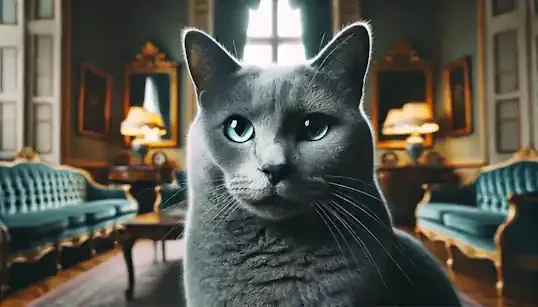Imagine a cat of understated elegance, a creature seemingly sculpted from moonlight and mist. Picture a feline with a coat that shimmers like spun silver, catching the light with every graceful movement, and eyes that gleam with the vivid intensity of emeralds, piercing and intelligent. If you are drawn to cats that embody a quiet sophistication, a gentle spirit, and an unwavering devotion to their chosen people, then the charming Russian Blue cat may just be the feline masterpiece you've been searching for. More than just a beautiful animal, the Russian Blue possesses an enigmatic aura, a touch of mystery that only enhances their allure. They are celebrated for their calm demeanor, their deep loyalty, and their ability to form profound bonds with their human families. This guide will take you on a comprehensive journey into the captivating world of the Russian Blue, exploring the whispers of their intriguing past, the captivating details of their striking appearance, the nuances of their refined personality, and the essential aspects of ensuring a long, healthy, and happy life for one of these truly exceptional cats. Whether you are already under the spell of the Russian Blue's quiet charm or are simply curious to learn more about this magnificent breed, prepare to be enchanted by their silver and emerald magic.
The origins of the Russian Blue cat are shrouded in a veil of romance and mystery, with whispers of a lineage stretching back to the icy landscapes of Northern Russia. The most captivating, though perhaps apocryphal, origin story links the breed to the Archangel Isles, also known as Arkhangelsk, a port city in northwestern Russia. Lore suggests that these striking silver-blue felines were natural inhabitants of this region, their dense, plush coats perfectly adapted to the harsh, cold climate. Adding to their mystique is the romantic notion that Russian Blues were once cherished companions of Russian Tsars and nobility, gracing the palaces of St. Petersburg and enjoying a life of royal pampering. The image of these elegant blue cats weaving through opulent rooms, attended to by servants and adored by royalty, certainly contributes to their air of inherent refinement and aristocratic grace. While definitive historical proof of this royal lineage remains elusive, the very suggestion of such an elevated past enhances the breed's allure and strengthens their reputation for understated elegance. It's a captivating origin story, one that perfectly complements the Russian Blue's quiet dignity and adds a layer of intrigue to their already fascinating persona.
Stepping away from the mists of folklore and into more documented history, we find the Russian Blue making their entrance onto the world stage in Victorian England during the late 19th century. Early cat shows, a burgeoning phenomenon in Victorian society, provided a platform for showcasing various feline breeds and types. Among the cats exhibited at these early shows were striking blue-grey cats, often grouped together under the umbrella term "Foreign Blues." Within this diverse category, the Russian Blue, with their distinctive silver-tipped coats and vivid green eyes, gradually began to stand out. Early cat fanciers recognized the unique qualities of these particular blue cats, appreciating their distinct type and recognizing them as more than just another blue variation. Over time, breeders began to focus specifically on developing and refining the characteristics of the Russian Blue, separating them from other blue breeds and working towards establishing a consistent breed standard. This period in Victorian England marks a significant step in the Russian Blue's journey from relative obscurity to becoming a recognized and admired breed within the formal cat fancy.
Despite gaining recognition and developing a dedicated following, the Russian Blue faced a significant threat to its very existence during World War II. Like many pedigree breeds, the chaos and disruption of wartime, coupled with limited resources and breeding efforts, brought the Russian Blue perilously close to extinction. The breed's numbers dwindled dramatically, and their future looked uncertain. However, thanks to the dedication and foresight of a few passionate breeders, particularly in Scandinavia and other regions, the Russian Blue was pulled back from the brink. These breeders recognized the value of the breed and worked tirelessly to rebuild their populations. To expand the limited gene pool and revitalize the breed, careful and selective outcrossing to other breeds, primarily Siamese and blue point British Shorthairs (in early lines), was undertaken. This judicious outcrossing, while controversial to some purists, was instrumental in re-establishing the Russian Blue and ensuring their survival. The genetic diversity introduced through these carefully managed crosses helped to strengthen the breed and provided a foundation for their continued development and eventual resurgence in popularity.
Following the challenging post-war period, dedicated breeders continued to refine the Russian Blue breed, solidifying their unique characteristics and working towards a more formalized breed standard. Different cat registries around the world, including the GCCF in the UK, the CFA and TICA in North America, and various European organizations, eventually established and refined specific breed standards for the Russian Blue. These standards meticulously outline the desired physical traits, coat color, eye color, body type, and temperament that define the ideal Russian Blue. The standardization of breed traits served to guide breeders in their efforts to maintain the breed's unique identity and ensure consistency across different breeding lines. Over the latter half of the 20th century and into the 21st, the Russian Blue experienced a remarkable resurgence in popularity, becoming a beloved and sought-after breed globally. Their quiet elegance, gentle nature, and striking appearance resonated with cat lovers worldwide, establishing them as a firm favourite within the cat fancy and a cherished companion in countless homes. The Russian Blue's journey, from whispers of royal origins to near extinction and eventual global admiration, is a testament to their enduring appeal, their resilience, and the unwavering dedication of those who recognized and preserved their unique and captivating charm.
The Russian Blue cat is a vision of understated beauty, a feline masterpiece defined by their shimmering silver coat, piercing emerald eyes, and graceful, refined physique. Their most defining feature, and the source of their evocative name, is undoubtedly their plush, double coat. This is not just any coat; it's a sensory experience, incredibly dense, luxuriously soft to the touch, and possessing a unique “stand-offish” quality that is truly distinctive. The “double coat” structure refers to the presence of two distinct layers of fur: a short, dense, and incredibly soft undercoat, and a slightly longer outer layer of guard hairs that are evenly distributed and of uniform length. This double coat construction, combined with the texture of the fur itself, creates the characteristic “stand-offishness.” When you stroke a Russian Blue, their coat feels remarkably thick and springy, almost like velvet that has been gently teased. It doesn't lie flat against their body; instead, it stands slightly away, creating a plush, rounded appearance that is both visually appealing and wonderfully tactile. The texture itself is exceptionally fine and silky, further enhancing the luxurious feel of their fur. While their dense double coat might suggest heavy shedding, Russian Blues are often described as relatively low-shedding compared to many other breeds. They are also frequently mentioned in discussions of hypoallergenic cats, although it’s important to clarify that no cat is truly non-allergenic. However, the Russian Blue’s coat structure and dander production are thought to contribute to them being better tolerated by some individuals with cat allergies.
The color of the Russian Blue coat is as distinctive as its texture, a breathtaking shade of silver-blue that is both elegant and captivating. It is a medium blue-grey, not a pale or washed-out blue, but a rich, even, and luminous shade. The key to the Russian Blue’s shimmering effect lies in the “tipping” of their guard hairs. Each individual guard hair is actually colorless at the very tip, creating a subtle silver sheen that overlays the blue-grey base color. This silver tipping is what gives the coat its characteristic shimmer and luminosity, catching and reflecting light in a way that is truly mesmerizing. Breed standards emphasize the evenness and clarity of the blue color, striving for a coat that is consistent in shade across the entire body, without any tabby markings or variations in color. It is important to note that Russian Blues are exclusively found in this specific shade of silver-blue. There are no other recognized color variations within the breed; this singular, exquisite coat color is a defining characteristic.
Providing a striking contrast to their silver-blue coat are the Russian Blue’s vivid emerald-green eyes. These intensely colored eyes are perhaps their most captivating feature, gleaming with intelligence and adding an undeniable element of allure to their overall appearance. The contrast between the cool, silvery coat and the warm, vibrant green eyes is a key aesthetic element of the breed, creating a visual impact that is both arresting and harmonious. The ideal eye shape is almond-shaped, set wide apart on their face, and exhibiting a clear, expressive gaze that reflects their intelligence and gentle nature. Interestingly, Russian Blue kittens are not born with emerald-green eyes. Like many kittens, they are born with yellow eyes, which gradually transition to green as they mature. The “greening up” process typically begins around 4-6 months of age, with the eyes deepening into their characteristic vivid emerald hue as they reach adulthood.
Beneath their plush coat and striking features lies a body that is equally elegant and refined. Russian Blues are classified as having a long, slender, and graceful body type, often categorized as “foreign” or “oriental” in type. They possess a fine-boned structure, contributing to their delicate appearance, yet they are surprisingly muscular and agile beneath their fur. Their bodies are well-proportioned and balanced, conveying an overall impression of grace and refined athleticism. Their head is moderately wedge-shaped, neither overly pointed nor excessively rounded, but rather exhibiting a balanced and refined profile. A key facial feature that contributes to their distinctive “smiling” or sweet expression are their prominent whisker pads. These well-developed pads give their muzzle a slightly rounded and softened appearance, enhancing their gentle countenance. Their ears are large, pointed, and set wide apart on their head, held erect and alert, contributing to their overall attentive and intelligent look. Their muzzle and chin are well-defined, completing their balanced and elegant facial profile. Their legs are long and slender, perfectly proportionate to their body length, further emphasizing their elegant stance and contributing to their graceful movements. Their paws are small and oval-shaped, appearing delicate yet surprisingly agile and allowing for nimble movements and quiet footfalls. In essence, the Russian Blue’s distinctive physical appearance is a meticulously crafted symphony of silver and emerald, plush fur and graceful lines, culminating in a feline of undeniable and enduring charm.
Living with a Russian Blue cat is to share your home with a creature of quiet grace, gentle affection, and understated elegance. Their temperament is as refined and captivating as their physical appearance, making them cherished companions for those who appreciate a calm and devoted feline presence. Russian Blues are renowned for their gentle and quiet demeanor, exuding an air of composed elegance in all their interactions. They are not typically boisterous or demanding cats; instead, they prefer a peaceful and harmonious environment. Their calm and composed disposition makes them wonderfully suited to quieter households and owners who appreciate a feline companion who is more serene than overtly energetic. Their understated elegance extends beyond their appearance to their behaviour; they are generally well-mannered and avoid unnecessary drama or attention-seeking antics.
One of the defining traits of the Russian Blue personality is their reserved nature, particularly when it comes to strangers. They are known to be initially shy and cautious around unfamiliar people, often taking time to warm up and observe before engaging. This shyness should not be misinterpreted as fearfulness; it is more accurately described as a dignified reserve, a preference for familiar faces and comfortable surroundings. While they may not immediately greet strangers with enthusiasm, their loyalty and devotion to their chosen family are unwavering. They form deep and lasting bonds with their owners, becoming fiercely devoted and deeply attached members of the household. Within their family circle, Russian Blues are affectionate and loving companions. While they may not be overly demonstrative or constantly demanding of attention, they express their affection in quiet, gentle ways. They enjoy cuddling and lap time, particularly when they initiate it, and appreciate gentle petting and quiet interaction with their loved ones. They are not typically clingy cats, but they thrive on calm, consistent affection and the reassuring presence of their human families.
Russian Blues are intelligent and observant cats, often described as “thinking cats” due to their thoughtful and deliberate nature. They are keen observers of their surroundings, carefully assessing situations before reacting, and exhibiting a level of awareness that is both intriguing and endearing. Their intelligence also makes them readily trainable, and they are capable of learning routines and understanding household dynamics with remarkable ease. Providing them with puzzle toys and interactive games is an excellent way to stimulate their minds and prevent boredom, appealing to their natural curiosity and problem-solving abilities. While not as overtly energetic as some breeds, Russian Blues do possess a playful side and enjoy engaging in toys and games. However, their play style is typically more moderate and refined, reflecting their overall understated elegance. They enjoy gentle chasing, batting at toys, and interactive play sessions, but they are not demanding of constant activity and are equally content with independent play or simply observing their surroundings from a comfortable perch. Their independent nature is another notable aspect of the Russian Blue personality. They are capable of being content in their own company for periods, exhibiting a degree of self-sufficiency that can be appealing to owners with busy lifestyles. While they thrive on social interaction with their families, they are not overly needy or clingy and can adapt to periods of solitude, provided they have a stimulating environment and receive ample attention and affection when their owners are present. In summary, the Russian Blue personality is a captivating blend of gentleness, reserve, loyalty, and quiet affection, making them truly charming and elegant companions for those who appreciate a refined and devoted feline presence in their lives.
Caring for a Russian Blue cat is a relatively straightforward and rewarding endeavor, reflecting their naturally elegant and low-maintenance nature. One of the most appealing aspects of Russian Blue ownership is their surprisingly low-grooming requirements. Their dense, double coat, while plush and luxurious, is remarkably easy to care for. Weekly brushing is typically sufficient to remove loose hair, keep their coat healthy and gleaming, and minimize shedding. A good quality slicker brush or a grooming glove is ideal for effectively brushing their double coat and maintaining its characteristic “stand-offish” texture. Bathing is generally infrequent and only recommended when truly necessary, as Russian Blues are naturally clean and fastidious groomers. Over-bathing can even strip their coat of its natural oils and potentially dry out their skin. Beyond coat care, routine nail trimming and dental care, including regular tooth brushing or veterinary dental checkups, are essential components of their overall hygiene, just as they are for any cat breed.
Providing a balanced and nutritious diet is crucial for maintaining the health and elegance of your Russian Blue. Feed them a high-quality cat food that is appropriate for their age, activity level, and indoor lifestyle. Choose a food that lists meat as the primary ingredient and is formulated to be complete and balanced for cats. Portion control is particularly important for Russian Blues, as they can be prone to overeating and weight gain if given unlimited access to food. Monitor their food intake carefully and adhere to feeding guidelines to prevent obesity, which can lead to various health problems. Fresh, clean water should always be readily available, ensuring proper hydration.
While not as overtly energetic as some breeds, Russian Blues still require daily exercise and playtime to stay physically and mentally stimulated. Provide them with scratching posts, cat trees, and a variety of toys to encourage play and movement within your home. Engage in gentle interactive play sessions with them daily, using toys that encourage chasing, batting, and pouncing. While they are not demanding of constant playtime, they do appreciate regular opportunities for interaction and physical activity. Mental stimulation is equally important for these intelligent cats. Provide them with puzzle toys, interactive feeders, and training sessions to keep their minds engaged and prevent boredom. Window perches offer opportunities for them to observe the world outside, satisfying their natural curiosity and providing environmental enrichment.
In terms of health, Russian Blues are generally considered a healthy and robust breed, often living long and healthy lives with fewer breed-specific health issues than some other pedigree cats. Hypertrophic Cardiomyopathy (HCM), a heart condition, can occur in Russian Blues, as it can in many cat breeds, although it is not considered to be particularly prevalent in this breed. Urinary tract issues, collectively known as Feline Lower Urinary Tract Disease (FLUTD), are another potential concern in cats in general, and ensuring adequate water intake and feeding a balanced diet can help mitigate this risk in Russian Blues. Choosing a reputable breeder who prioritizes health and responsible breeding practices is always recommended. Regular preventative veterinary care is paramount for maintaining their long-term health and well-being. Annual vet checkups, vaccinations, parasite prevention, and dental care are essential for all cats, including Russian Blues. Due to their gentle nature and desire to protect their elegant coats and overall well-being, an indoor lifestyle is strongly recommended for Russian Blue cats. Indoor living protects them from the dangers of traffic, predators, diseases, and the elements, ensuring a safer and healthier life. In summary, caring for a Russian Blue cat is a graceful partnership that emphasizes low-maintenance grooming, balanced nutrition, moderate exercise, mental stimulation, and proactive health management, allowing these charming and elegant companions to thrive in their loving homes.






